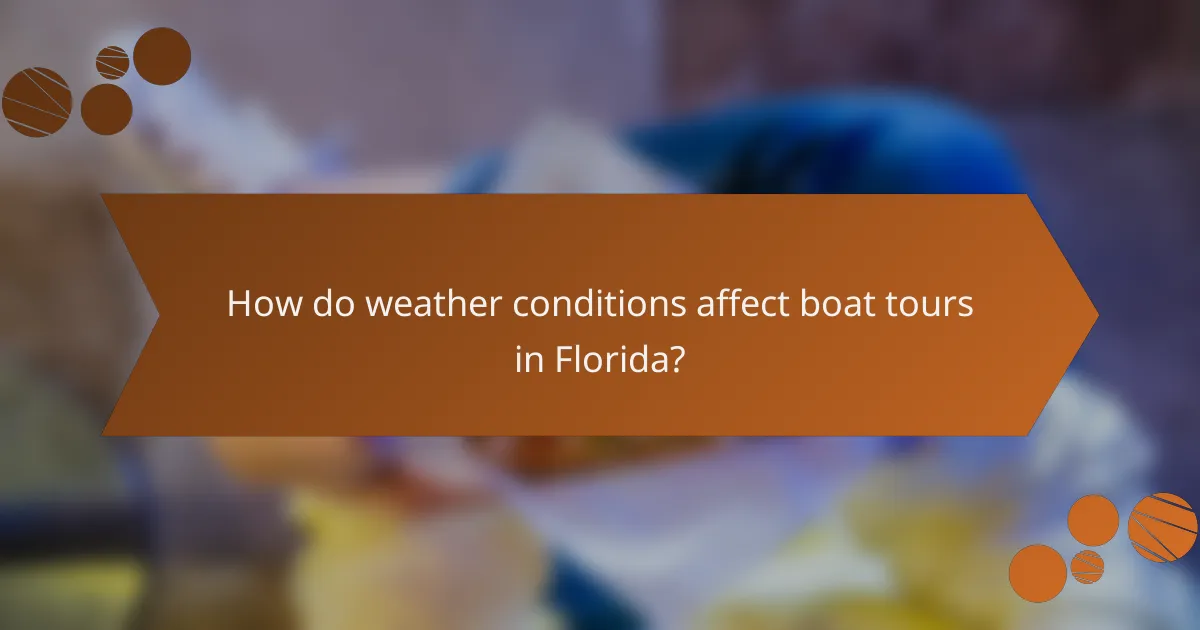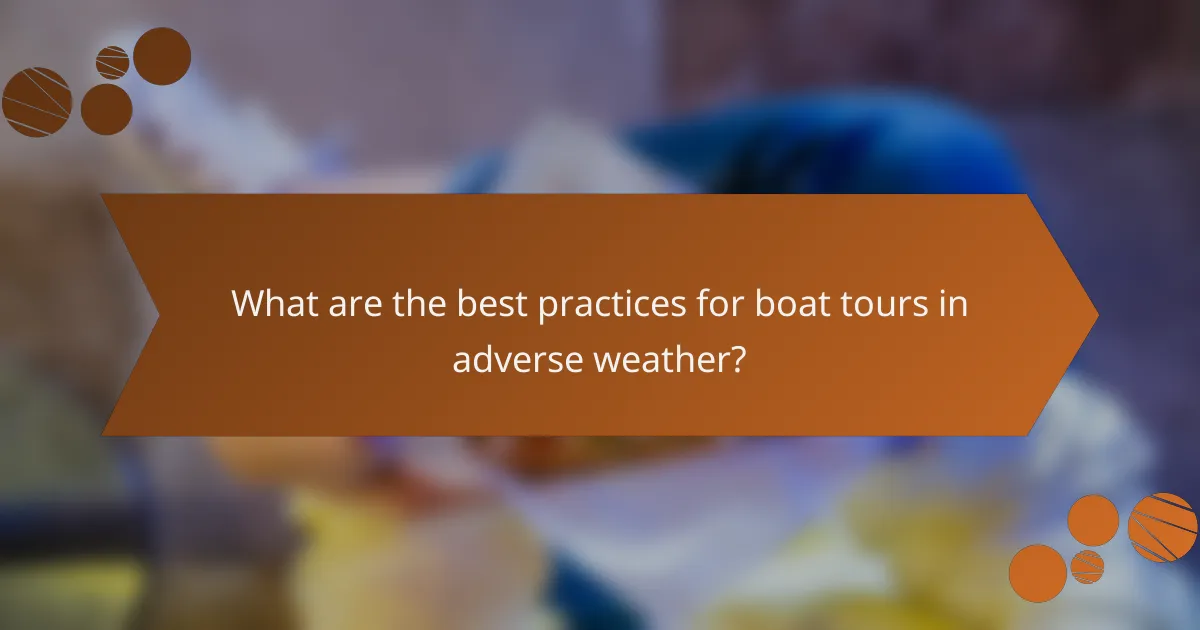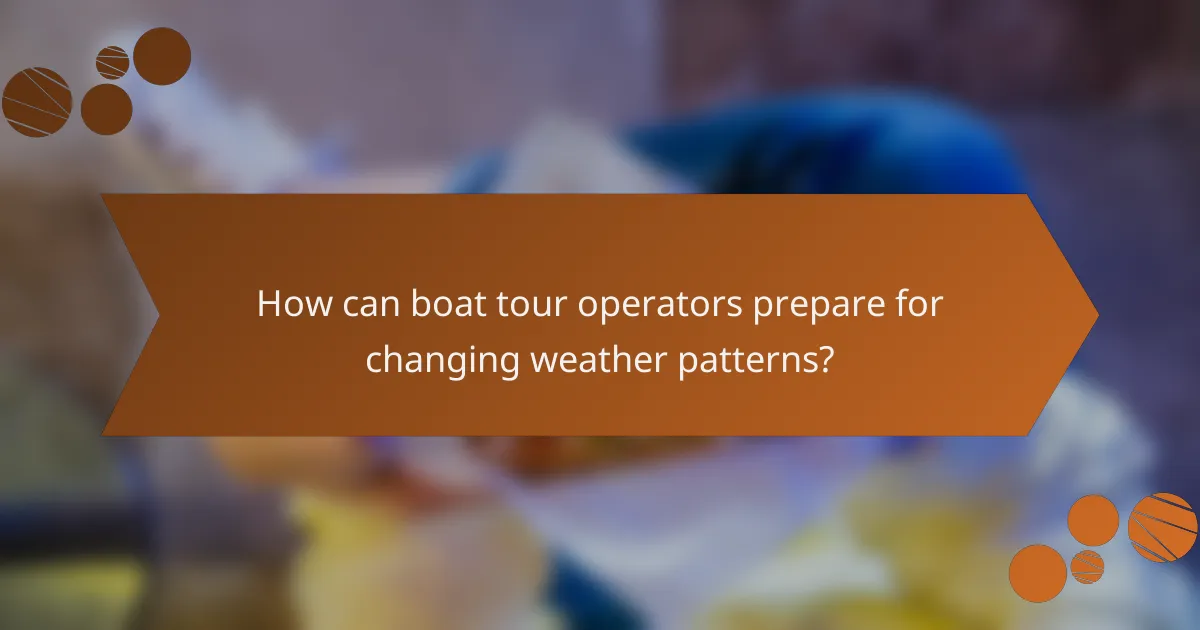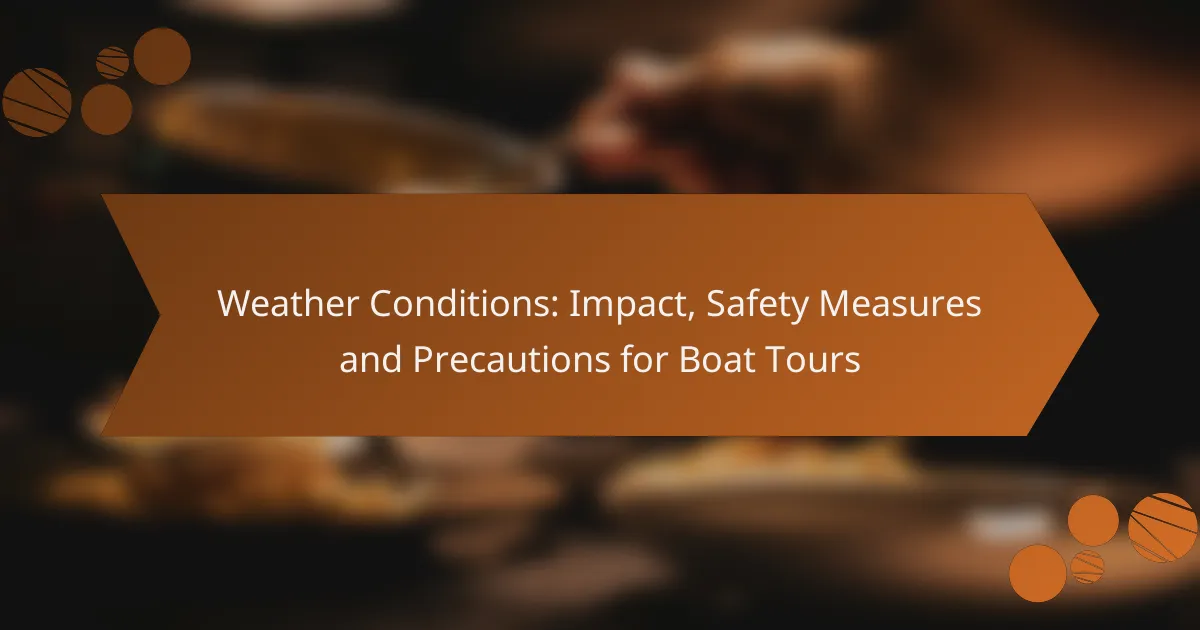Weather conditions play a crucial role in the safety and enjoyment of boat tours, particularly in regions like Florida. Factors such as wind, rain, and temperature can greatly affect visibility and passenger comfort, necessitating careful planning and precautionary measures to ensure a safe experience on the water.

How do weather conditions affect boat tours in Florida?
Weather conditions significantly impact boat tours in Florida, influencing safety, visibility, and passenger comfort. Factors such as wind, rain, and temperature extremes can alter the experience and safety of a boat trip, requiring careful consideration and planning.
High winds impact safety
High winds can create dangerous conditions for boat tours, leading to rough waters and increased risk of capsizing. Wind speeds above 15 knots are generally considered challenging for smaller vessels, while larger boats may handle up to 25 knots with caution.
Operators should monitor weather forecasts and avoid scheduling tours during high wind warnings. If winds are expected to exceed safe levels, it’s best to reschedule or cancel the trip to ensure passenger safety.
Heavy rain reduces visibility
Heavy rain can drastically reduce visibility on the water, making navigation difficult and increasing the risk of accidents. When visibility drops below a few hundred meters, it’s advisable to postpone boat tours until conditions improve.
Tour operators should equip vessels with proper navigation lights and instruments to enhance safety during rain. Passengers should also be informed about the potential for sudden downpours and the importance of wearing appropriate rain gear.
Temperature extremes affect comfort
Temperature extremes can affect passenger comfort during boat tours in Florida. High temperatures can lead to heat exhaustion, while cold conditions can cause discomfort and hypothermia, especially during evening tours.
It’s essential to provide adequate hydration and sun protection during hot weather, such as sunscreen and hats. In cooler conditions, passengers should dress in layers and be informed about the potential for temperature drops on the water. Operators should consider these factors when planning tours to ensure a pleasant experience for all.

What safety measures should be taken during boat tours?
During boat tours, essential safety measures include ensuring all passengers wear life jackets, monitoring weather conditions, and having emergency communication devices on board. These precautions help to minimize risks and enhance safety for everyone involved.
Life jackets for all passengers
Life jackets are crucial for the safety of all passengers during boat tours. Every individual should have a properly fitted life jacket readily available, regardless of their swimming ability. It’s advisable to check that the life jackets meet local safety standards and are in good condition before departure.
Ensure that life jackets are easily accessible and that passengers are instructed on how to wear them correctly. Conduct a brief safety demonstration to familiarize everyone with the equipment, emphasizing the importance of wearing life jackets at all times while on the water.
Weather monitoring systems
Weather monitoring systems are vital for maintaining safety during boat tours. These systems provide real-time updates on weather conditions, helping boat operators make informed decisions. Utilizing reliable weather apps or onboard radar can help identify potential storms or hazardous conditions.
It’s recommended to check weather forecasts before setting out and to continuously monitor conditions throughout the tour. If severe weather is predicted, have a contingency plan in place, such as returning to shore or seeking shelter.
Emergency communication devices
Emergency communication devices are essential for ensuring safety during boat tours. Equip the boat with a VHF radio, satellite phone, or personal locator beacon to maintain communication with emergency services if needed. These devices can be lifesavers in case of an accident or unexpected situation.
Regularly test communication devices to ensure they are functioning properly. Make sure all crew members know how to use them effectively and have a clear plan for what to do in an emergency, including designated signals or codes for distress situations.

What precautions can enhance safety on boat tours?
Enhancing safety on boat tours involves a combination of thorough planning, weather assessments, and crew training. Implementing these precautions can significantly reduce risks associated with adverse weather conditions.
Pre-tour weather assessments
Conducting pre-tour weather assessments is crucial for ensuring safe boat tours. Check local weather reports and forecasts to identify any potential hazards such as storms, high winds, or rough seas. Utilize reliable sources like national meteorological services or marine weather apps.
Consider assessing conditions at various times leading up to the tour, as weather can change rapidly. Monitoring updates until departure can help you make informed decisions about proceeding with the tour or rescheduling.
Route planning based on forecasts
Effective route planning based on weather forecasts is essential for safety. Use the latest weather data to select a route that avoids areas prone to severe conditions. This might involve choosing sheltered waters or adjusting the itinerary to stay clear of storm paths.
Incorporate alternative routes into your plan, allowing for flexibility if conditions change. Always communicate the planned route and any adjustments to the crew and passengers to ensure everyone is informed and prepared.
Training for crew on emergency procedures
Training the crew on emergency procedures is vital for managing unexpected situations during boat tours. Ensure that all crew members are familiar with safety protocols, including evacuation procedures, first aid, and communication methods in case of emergencies.
Regular drills can help reinforce these procedures, allowing the crew to respond quickly and effectively. Consider reviewing safety equipment and ensuring that all crew members know how to operate it, enhancing overall safety during the tour.

What are the best practices for boat tours in adverse weather?
Best practices for boat tours in adverse weather include prioritizing safety by postponing trips, using sheltered routes, and implementing flexible scheduling. These measures help ensure the safety of passengers and crew while minimizing risks associated with unpredictable weather conditions.
Postponing tours in severe conditions
Postponing tours during severe weather is crucial for ensuring passenger safety. If forecasts predict storms, high winds, or heavy rainfall, it is advisable to delay the tour until conditions improve. This not only protects those on board but also helps maintain the reputation of the tour operator.
Operators should monitor weather reports closely and have a clear policy in place for cancellations. Communicating promptly with customers about any changes can help manage expectations and reduce frustration.
Using sheltered routes
Choosing sheltered routes can significantly enhance safety during adverse weather conditions. These routes, which may include bays or inland waterways, provide protection from strong winds and waves. Operators should familiarize themselves with local waterways to identify the safest paths available.
When planning a tour, consider the typical weather patterns for the season. For example, in coastal areas, certain routes may be more sheltered during specific months, allowing for safer navigation even when conditions are less than ideal.
Implementing flexible scheduling
Implementing flexible scheduling allows tour operators to adapt quickly to changing weather conditions. This can include offering multiple time slots or allowing customers to reschedule without penalties. Flexibility helps ensure that tours can proceed safely when conditions improve.
Additionally, operators can use technology to communicate real-time updates to customers. Text alerts or app notifications can inform passengers of any changes, enhancing their experience while prioritizing safety.

How can boat tour operators prepare for changing weather patterns?
Boat tour operators can prepare for changing weather patterns by investing in advanced forecasting technology, training their staff on climate resilience, and adapting their operational protocols. These strategies help ensure safety and enhance the overall experience for customers, even in unpredictable weather conditions.
Investing in weather forecasting technology
Utilizing reliable weather forecasting technology is crucial for boat tour operators. This includes subscribing to advanced meteorological services that provide real-time updates on weather conditions, such as storms or high winds, which can affect safety and scheduling.
Operators should consider tools like radar systems, satellite imagery, and mobile apps that offer alerts and forecasts. Investing in such technology can significantly reduce the risk of weather-related incidents and improve decision-making regarding tour cancellations or modifications.
Training staff on climate resilience
Training staff on climate resilience involves educating them about the impacts of changing weather patterns and how to respond effectively. This training should cover emergency protocols, safety measures, and customer communication during adverse weather conditions.
Regular drills and workshops can help staff become familiar with procedures for evacuating passengers and securing the vessel. Empowering employees with knowledge and skills enhances safety and instills confidence in customers during unpredictable weather events.
Adapting operational protocols
Adapting operational protocols is essential for maintaining safety amid changing weather conditions. Operators should establish clear guidelines for assessing weather risks before and during tours, including criteria for canceling or altering routes based on forecasted conditions.
Additionally, implementing flexible scheduling can allow for quick adjustments in response to weather changes. Operators may also consider developing a checklist for pre-departure safety assessments, ensuring that all equipment is secure and that passengers are informed about potential weather-related risks.
